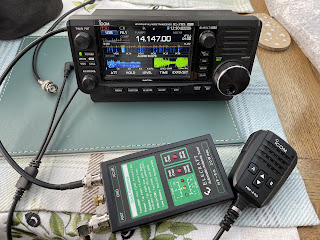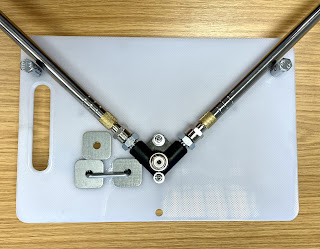DIY TELESCOPIC-V ANTENNA £35
This is the story of a little antenna experiment. I haven't really got a clue what I'm doing, but I never let that hold me back, lol.
I was recently walking the streets of eBay when I stumbled upon a pair of telescopic whips with what appeared to be 3/8 UNF threaded ends. This reminded me of an antenna I'd seen on the ML&S website - a MyDel JPC-7 , which was basically a telescopic V antenna mounted on top of a tripod, with loading coils for each leg of the antenna. At £340 it seemed a tad expensive, but in all fairness, you got everything you needed including the tripod and carry-case.The telescopic whips in question are each over 5M long when fully extended and a pair can be obtained from ML&S for £50, but on eBay I found them for £24.
Now bear in mind, the cheaper whips that I bought are probably of a lower quality than those offered by ML&S.
When the package arrived a few days after ordering, I was saddened to see that there was only one whip in the box, so I lodged a complaint and quickly received another, along with a 10% refund.
The next thing to order was a V-Shape Dipole Centre, 3/8 to SO-239 at a cost of £11. This would provide the mounting point for the Dipole and give it the V-shape layout for the whips. How strong it is, I'm not really too sure at this point, but it does seem pretty good for light, portable use (ie, not left on top of a roof in howling winds forever).
The next hurdle to get over was how to mount the whips to a mast. I had a mast in mind already (my Diamond AM450 4.5M). I started out by fixing the V-Centre SO-239 to a stainless-steel plate from work and drilling holes in the plate to accept a vertically oriented mount or a 45 degree mount (to switch from V to L).
On the reverse side I mounted a Grounding Plug terminated with a female banana socket so that I could easily connect a ground.
With the mast at full height and the whips fully extended to 10 metres, the antenna will obviously be quite a handful without being guyed off. Thankfully, the AM-450 has a built-in guy-ring, so all I'll need is a few lengths of paracord and some tent-pegs.
OOPS!! Change of mind. Although the above design looked really neat and compact, I soon realised that it offered nothing in terms of support to the long whips. Maybe they don't need it - but I was uncomfortable nonetheless, so I went bigger.
Having more space to work with meant that I could offer some support, even though it's only a small amount. I achieved it by placing bolts in the upper corners and isolated them from the whip using part of a Sharpie Pen. Well, you gotta use what's laying around don't you? 😂
I did a quick test to see how it looked but it was incredibly windy, which meant I couldn’t really extend the whips. I did try, but I could see it had all the potential for going pear-shaped, so I only extended the first three sections.
To be honest, I was also not much in the mood for spending any more time outside in the bitter cold after just spending 3 hours cleaning my drive 🥶
Although the weather brightened up by the time the drive was finished, it had got much colder. I’m convinced there’s snow on the way! I’ll just have to wait for a better day to do my trials, but at least I feel happy with the antenna support - it seemed to be strong enough and stable on the Diamond AM-450.
So far so good. But there's a couple of very important components missing here, and that's the loading coils. You can, of course, purchase these loading coils and probably even make your own, but first of all, I wanted to see it I could get away without them by tweaking the whip lengths and using my Elecraft T1 ATU.
I figured that the best way to start out would be to erect the antenna and connect my NanoVNA to get an idea of where I stood on each band and then adjust the whip-lengths to find the best possible setting. I wasn't really expecting to achieve much, other than to give my tuner the best chance of finding a match.
The next day the weather improved slightly, so I erected the antenna on the patio, connected a ground wire and raised the mast to 4 metres high. Sadly, my VNA refused to power up, so that looks like another little project to strip it down and see if I can find out what’s gone wrong with it 🤬
In the absence of an analyser, I decided to go straight to the antenna test with each leg of the dipole extended to 5.28M. I fitted a 1:1 balun to prevent the coax becoming an RF radiator, connected the ATU and jumped onto the 20M band.
I could see straight away from the busy waterfall that the antenna was pulling in plenty of signals on this band. It was quite busy and so I attempted to make some contacts with my IC-705 on its maximum 5W output (internal battery).
My first QSO was with Ricardo (LX2AM) in Luxembourg. He was struggling to hear me but was very patient and gave me a 13 signal report. Not the start I was hoping for. Soon after though, I switched to the 17M band and got a 55 from Antonio (IU6QLJ) in Italy.
After that, I got another three contacts on 20M (DL0AH, DH1TT, F4ELA) before switching to 15M to get a 59 from II2WRTC.
Then I moved to 40M and made contact with G3SIG before finally speaking with SP8ALT on 10M.
The rain and wind decided to spoil the fun, so I quickly dismantled the antenna and called it a day. I was quite pleased with this initial test and it was good to make contact on 5 bands. I was surprised to see that the antenna also tuned up on the 6M band (50.300MHz SSB) but there was no one around to answer my CQ calls.
The thing to bear in mind is that this first test was done in a poor location and I very much look forward to trying it out from a hillside or seaside, which is where it would naturally be used.
I also need to look at MAYBE buying or making a loading coil because some bands just couldn’t be tuned - not even with the mighty Elecraft T1 😮. The only trouble with introducing a loading coil is that I’d need two - one for each whip - and I’m not sure I want to go that far. If it gets too complicated, I’d probably just use my SotaBeams Linked Dipole.
The attraction of the V-Antenna is that it has a relatively small footprint which makes it handy to use in certain places.
Ah well, we’ll see what happens in the next test, where I’ll be at a much better take-off location.
Until then, best 73, Tom, M7MCQ.
UPDATE <<< 5th FEB 2023
I altered the mounting plate (again). This time I used a UPVC Chopping Board! It’s light, strong and simple to work with. It also spreads the support-posts further apart from each other which helps.
Today I decided to see if I could get it to work on 4M, so I started by extending each leg to around 1100mm long and connected it to my NanoVNA. I guess I got lucky because the SWR was 1.12:1
With a little more fiddling, I got a perfect match and so I attached my Wouxun KG-UV8G and put out a call. Immediately, my friend Bill (G4CFP) returned to the CQ. He lives in the same town as me, so it was no test of reach, lol 😂 but at least it proved it worked. He said it sounded perfect, so that’s a good start.
Just need to spend a day on top of Winter Hill with it.
G4CFP
UPDATE <<< 7th FEB 2023
I mentioned that the whips were cheap and cheerful at £24 for the pair, well it turns out the quality was not good. One of the end sections completely came out and I suspect that the others will be equally vulnerable. Once this happens, there's no going back because they become very loose - to the point where you would end up taping them to hold them in place.
Obviously that's not good, so I've sent off for a new pair from ML&S.
Buy cheap, buy twice!! 😳


























































